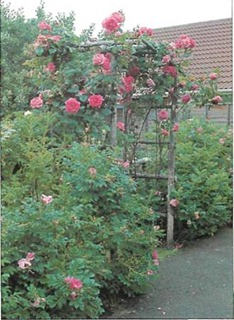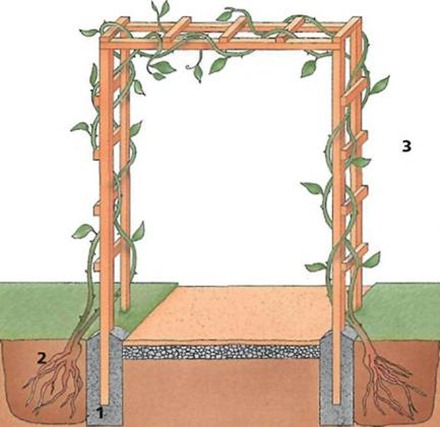





It’s hard to imagine a better way to enter any garden than to step beneath a canopy of beautiful, aromatic roses. Train scented varieties around a freestanding arch to create a focal point in the garden.
A rose arch leads the eye down the garden and provides a romantic ‘door’ to walk through. Established plants soon cover the arch in a profusion of flowers.
Once you embark on this exciting project your first decision is which rose to buy. The choice lies between a climbing or a rambling variety.
As neither type has tendrils or twines, you will need to provide a sturdy support and tie in new growth regularly.

Vigorous varieties of climbing rose will cover your structure relatively quickly, but the less prolific rambler types produce thin, pliable stems which are easy to bend and train.
Climbing roses have stiffer stems and produce smaller trusses of flowers than the rambling varieties, but each individual bloom is larger. Climbers flower on mature wood which creates a fairly permanent framework around the support, but they need regular pruning to remove dead wood and to keep the plant looking tidy.
There are several different types of climber, including some recent introductions which have been bred to be tough and resistant to disease.
Rambler roses have been popular since Victorian times. They produce huge trusses of small flowers which create a mass of colour in summer.
There are some drawbacks to choosing this type of rose. Most ramblers produce only one flush of flowers per year. Some are prone to mildew and need regular spraying. Pruning a rambler is more difficult than pruning a climbing variety as the flowers grow on new wood. This means that old wood must be trimmed hard at the end of flowering to encourage new shoots. However, the extra care ramblers require seems well worth it when you see the flowers in full bloom over an arch.
Whichever type of rose you choose, plant it carefully and do not expect to get too many blooms during the first year.
Begin training the rose straight after planting. Tie the main stems to the arch using durable string or plastic ties. Raffia is not suitable for tying roses as it will rot and break. Do not tie the stems too tightly, as they will thicken with age. Continue to tie new growth to the arch as it appears.
Arches for roses are available ready made in a number of materials: lengths of plastic-coated metal, rustic or smooth timber or galvanized steel tubes. Alternatively, you can make your own rose arch out of wooden uprights and cross-pieces screwed together.
Plastic-coated arches need no extra care, but wooden arches need treating with either paint or a timber preservative suitable for garden use. It is also essential to anchor the arch firmly in the ground as strong winds can cause a lot of damage to a structure when roses are in full leaf.
TIP
PRESERVING WOOD
Before building a wooden arch, treat the wood with a suitable preservative sold at garden centres and nurseries. The chemicals in this type of preservative will prevent the wood from rotting without causing damage to the plants. Do not use creosote as a preservative, as it can be harmful to plants and even kill them.
Regular pruning keeps roses healthy and flowering prolifically. Prune climbing varieties lightly in spring when new growth is just beginning. Remove dead and unwanted wood and withered shoot tips. Reduce lateral branches on wood which flowered the previous year to about 8cm. Remove dead flower-heads regularly to encourage repeat flowering.
Because ramblers only produce blooms on new wood, they need much harder pruning each year. When a rambler is trained over an arch it is best to cut back as much of the old wood as possible. Any old wood left will not bloom well. Prune ramblers in late summer or autumn as soon as they have finished flowering, to encourage new growth.

1. Set the ends of the arch in concrete, to a depth of at least 30-40cm.
2. Let the concrete set, then dig out the planting holes at either side of the arch.
3. Tie new growth to the arch as it appears, twisting the stems through the arch.
Copyright © www.100flowers.win Botanic Garden All Rights Reserved